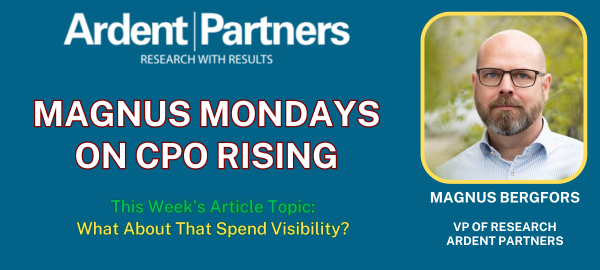Last week OpenAI released its new flagship model GPT-4o (o is for omni, as in working across audio, visuals, and text at the same time). GenAI news and hype is all over the procurement tech space, which leads me to feel like some of the more fundamental building blocks of procurement technology are almost being forgotten. In this week’s article, I’m going to bring the discussion back to one of these fundamental procurement tools, spend analytics — which I would argue lays a lot of the groundwork for any AI technology.
I’ve always considered spend analytics and visibility into external spend as one of the most important and foundational solutions and capabilities for a procurement organization. And over the last decade, spend analytics solutions have improved dramatically. AI technologies, especially machine learning and deep learning, are very applicable to normalizing, classifying, and even enriching spend data. That said, access to good quality data remains an issue and improving this should be high on any CPOs’ agenda.
Let’s look at some of the most important reasons why you should invest in spend analytics if you haven’t already.
Create Your Baseline
For accounting and reporting purposes, all organizations must keep track of external spend. This accounting-focused tracking, however, is not really useful for procurement purposes. In order to run a successful procurement organization, you need more detailed and granular procurement-specific insight into your external spend. By leveraging a spend analytics tool, you should be able to understand what is being bought (classified to the correct level in your category tree), for how much, and by whom. By knowing this, you can start to track performance, plan the work, prioritize opportunities, and enable better forecasting.
Track Performance
Cost savings and avoidances remain a key focus for CPOs, making spend analytics necessary to accurately track both. Savings reported at the end of sourcing projects are at best indicative forecasts of what the actual savings are going to be, as factors such as volumes, currency rates, product/service mix, and much more will change. To get the actual bottom-line savings, item-level spend analytics must be done. Theoretically, it could be done manually but automating it with a dedicated solution (or module of a broader suite) is far more efficient. A good spend analytics tool will help you track sourcing initiatives and allow you to compare the predicted vs. actual outcome.
Planning and Prioritizing
While most organizations have a good idea of their largest suppliers and spend categories, the biggest opportunities are not as obvious. By using spend analytics, you can identify spend categories with large amounts of off-contract spend or spend that hasn’t been sourced, as well as categories with too many suppliers or instances where business units are paying different prices for the same item/service category.
Knowing what you are buying and from whom is also critical from a risk management perspective. Enriching spend and supplier data with risk information (e.g., financial status, geopolitical risk, etc.) can give a high-level view of the risk situation.
Knowing where the risks and opportunities exist is an obvious, but too often overlooked, input into resource allocation and staffing.
Forecasting and Scenario Modeling
Spend analytics is sometimes criticized for focusing on historical data and not being updated often enough. While that’s true for some, recent developments with API’s and spend analytics modules — as part of broader suites — update spend more frequently. For most use cases, monthly or quarterly updates are what buying organizations are doing.
But spend analytics capabilities are becoming increasingly forward looking as well. We should be careful with terms like “predictive analytics,” but forecasting and scenario modeling is certainly possible. By establishing a correlation between demand and supply, different demand scenarios can forecast spend impact. For indirect categories, proxies can be defined for some categories (e.g., employee count impacts on laptop costs, office space impacts on facility management, and so on).
Plenty of Options
While most of the suite vendors, such as Coupa, GEP, Ivalua, and SAP, have invested or are planning to invest heavily in spend analytics, there are also some specialists remaining in the spend analytics space. Solution providers like Sievo and SpendHQ are laser focused on spend analytics and are pushing the limits of analytics in procurement beyond yesterday’s solutions.
As always, Ardent Partners is here to help if you have any questions about spend analytics in general or the providers of spend analytics solutions.
RELATED RESEARCH
Magnus Mondays — Category Management: All Talk No Action?
Magnus Mondays — Make vs. Buy: Procurement Tech Edition
Procurement Experts on CPO Rising — Transformative Spend Analytics
The Real Value of Spend Analytics
Next-Gen Spend: Accelerating Procurement Performance with Spend Analytics

